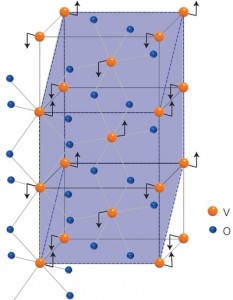Vanadium dioxide, one of the few known materials that acts like an insulator at low temperatures but like a metal at warmer temperatures, is a somewhat futuristic material that could yield faster and much more energy-efficient electronic devices. Researchers from IBM’s forward-thinking Spintronic Science and Applications Center (SpinAps) recently used the ALS to gain greater insight into vanadium dioxide’s unusual phase transition.
“Vanadium dioxide is a very special material because it changes its phase abruptly at a particular temperature, from being an insulator at low temperatures to being a metal at higher temperatures,” says Stuart Parkin, IBM Fellow and Manager of Magnetoelectronics at IBM’s Almaden Research Center. “If we could control that phase transition using other means, such as an electric field, we could potentially create some very interesting devices for novel memory and computing applications.”

The ability to control vanadium dioxide’s phase transition could form the basis for an ultrafast electronic switch, in which devices would be activated so quickly that very little energy would be lost through dissipation. To gain improved understanding of the origin of the metal-insulator transition of vanadium dioxide, Parkin led a group of researchers in studying thin films of the material at Beamline 4.0.2. Using the undulator beamline’s variable linear polarization, they performed a series of strain-, polarization- and temperature-dependent x-ray absorption spectroscopy experiments, in conjunction with x-ray diffraction and electrical transport measurements. The researchers were able to penetrate the vanadium dioxide thin films to a depth of about five nanometers, providing a probe with minimal effects from surface adsorbates.
“With the characterization capabilities of the ALS, we were able to explore the atomic orbitals that contribute to vanadium dioxide’s electronic structure and to understand how the ordering and filling of these orbitals change as the material goes through its phase transition,” says Parkin.
Parkin and his group of researchers found that by varying the thickness of a buffer layer on which they grew the vanadium dioxide film, they were able to change the strain in that film and thereby vary the ordering temperature. They found that the ordering temperature is influenced by the orbital occupancy in the high-temperature metallic phase rather than that of the insulating phase, which was quite a surprise.
“It was crucial for the experiment to be performed at a beamline where the orientation of the x-ray polarization could be changed from parallel to perpendicular without moving the sample,” says Elke Arenholz, the ALS beamline scientist who manages Beamline 4.0.2. “Beamline 4.0.2 also provided the stability and accuracy needed to measure tiny effects.”
The results of this research have been reported in the journal Nature Physics in a paper titled “Control of the Metal-Insulator Transition in Vanadium Dioxide by Modifying Orbital Occupancy.”